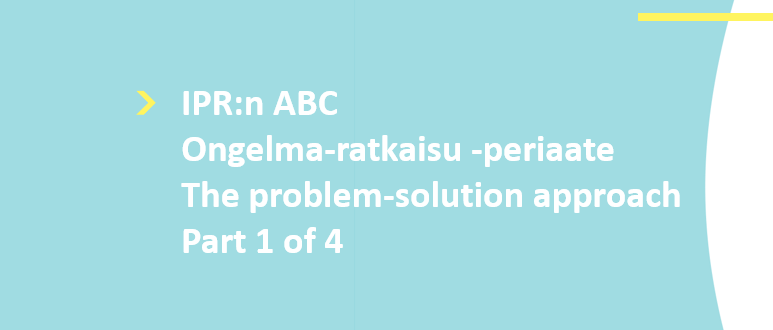The problem-solution approach in determining inventive step

- Kathy Wasström
- –
- News
- –
- 23.11.2020

Inventive step is one of the most important criteria of a patentable invention. At the same time it is one of the most difficult criteria to define.
In order to be inventive, an invention should not be obvious to a person skilled in the art. The term “obvious” is, in turn, typically defined by evaluating whether a particular development is to be seen as a part of the expected progress of the relevant technology, or whether it could be considered unexpected.
A few different methods have been developed to help with the evaluation of inventive step. The problem-solution approach is a commonly used method particularly in Europe.
Although the original goals of said approach included that it would make it possible to evaluate inventive step in an objective manner, by avoiding hindsight, particularly the latter part of this goal has been challenging, also using this method. A successful evaluation of inventive step does require the evaluation of the claim features as if these features would not be known.
However, the problem-solution approach is still highly useful.
Based on the Guidelines for Examination, originally drawn up for the Examiners of the European patent office, the problem-solution approach contains three main steps:
- selecting the closest prior art among the available publications,
- defining the objective technical problem, and
- evaluating the invention based on these.
1. Closest prior art
The closest prior art is the publication that would have been the most promising starting point for any such development that would have resulted in the invention to be evaluated.
The most important issue to consider, when selecting the closest prior art, is that the publication should belong to the same, or a very close, technical field as the invention that is evaluated.
They can both, for example, describe a fibrous product, even if they describe products having different properties. Thus, the technical field could be “fibrous products”.
Secondly, the document representing the closest prior art should be intended for the same purpose as the invention to be evaluated, for example by aiming at improving the same property.
In practice, it is common to merely carry out a comparison of the structural and functional features of the invention and the corresponding features described in the publication.
2. The objective technical problem
In defining the objective technical problem, the differences between the invention to be evaluated and the document selected in the previous step to represent the closest prior art are first determined, as well as the effects or advantages achieved using these differences.
Typically, the definition is based on asking how a specific effect or advantage, that is not achieved using the closest prior art, could be achieved for a specific method or product in a specific technical field.
The objective technical problem can be said to be a problem that is solved by the invention to be evaluated, but not solved by the closest prior art. It may for example be related to an improvement of the solution of the closest prior art, or it may relate to an alternative manner of achieving a certain desired effect, i.e. a manner that is different from the one of the closest prior art.
This is a difficult step of the method, where also a patent professional may fumble. It is very easy to take a shortcut in defining the objective technical problem, and merely make a general comparison of the improvements made in the new invention to various known alternatives, or combinations of such known alternatives. This does, however, not comply with the guidelines for the problem-solution approach.
In defining the objective technical problem, only the document selected to represent the closest prior art should be used for said comparison. No other known alternatives should be taken into account in this step, no matter how well known they are.
3. Final evaluation of the invention, i.e. does the prior art, overall, guide the person skilled in the art in the right direction?
In the final step of the problem-solution approach, it should be determined whether the person skilled in the art could solve the objective technical problem defined in the previous step, using one further disclosure.
In other words, would the person skilled in the art, based on a second disclosure, have made the decision to carry out the needed changes or improvements to the disclosure of the closest prior art in order to achieve the invention to be evaluated.
Therefore, other prior art, in addition to the closest prior art, can finally be considered in this step of the problem-solution approach. More precisely, the disclosure of the closest prior art can now be combined with the teachings of one other publication.
For example, a method to be evaluated might be considered obvious (not inventive) if it can be achieved by adding one method step from a second publication to the method of the closest prior art.
Such a combination of teachings from two prior art documents is acceptable if it can be demonstrated that the person skilled in the art would have had a reason to read the second disclosure. This second document being from a similar technical field as the closest prior art is, however, a perfectly acceptable reason.
The combination of teachings should also be simple to perform, and not require any unreasonable modifications of the steps already disclosed in the closest prior art. Preferably, the closest prior art should also contain some incentive that guides the person skilled in the art to find improvements in the type of technology that is described in the other document.
If such an acceptable combination of documents is found, the invention to be evaluated is considered to be obvious.
Recent developments
In the past, it has been possible, for example when responding to an Office Action, or in opposition cases, to argue in favor of, or against, inventive step by briefly referring to the differences between the invention and the closest prior art, and to the advantages achieved using these differences, or the lack thereof.
However, during the past years, patent offices have adopted a more strict approach, where the complete problem-solution approach should be presented also in simple cases.
Even if it might feel unreasonable, it may have a clear advantage in some cases. When the complete problem-solution approach has been presented once, it can easily be referred to in subsequent proceedings.

